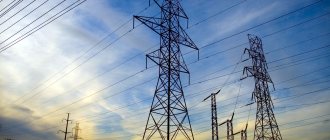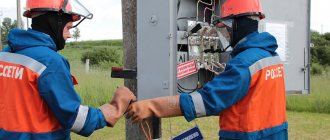Introduction
The energy sector, or more precisely the part dealing with electrical energy, includes many electrical installations that require grounding to operate. Depending on the purpose of the object, it is important to organize the correct grounding device. It must perform the functions of protective grounding, which serves to ensure electrical safety, as well as the worker necessary to ensure the operation of electrical installations, including the purpose of protection against operational damage, for example, short circuit, and dangers arising from lightning strikes.
Grounding is necessary not only for the operation of electrical machines and devices, but also for the operation of automation and electronics devices, which contribute to the management and control of work processes, the protection of electrical installations from damage during accidents and malfunctions, as well as the prevention of accidents themselves. Otherwise, if the grounding is organized incorrectly, or is completely absent, there is a risk that, as a result of emergency situations, the electrical installation will be taken out of operation for the time necessary to detect and eliminate their cause. During this entire period, sometimes taking several hours or even days, consumers, starting from a residential building and ending with a district, city, or federal subject, will be without electricity. The consequence of power supply interruptions can be financial losses due to production downtime and threats associated with disruption of the life support sector.
To avoid power outages, it is important to ensure trouble-free operation of facilities for the production, conversion, transformation, transmission, distribution and consumption of electrical energy. This is ensured by many factors, including the organization of high-quality grounding that complies with regulatory documents.
Connection features
When designing and installing any grounding system, the main attention should be paid to ensuring high reliability of bolted joints and welded contacts between its individual components.
Since such structures are designed for long-term operation, it is necessary to minimize possible mechanical loads on them, as well as to ensure reliable protection of metal surfaces from corrosion.
When installing protective grounding in home wiring conditions, first of all, it is necessary to decide on the arrangement of supply lines.
The fact is that in old buildings built before 2003, regulatory requirements did not provide for the presence of a separate grounding conductor in the supply circuit. In such houses, on the consumer side (at the distribution panel), there are only 2 wires in the supply wiring - “phase” and “neutral”.
Moreover, the latter is a combined zero working (PE) and zero protective (N) cores and, according to the international standard, is designated as PEN.
To install grounding in such houses, the PEN conductor is deliberately split into two components, after which a separate conductor N is used as a grounding bus.
It is clear that the artificial structure created in this way only partially complies with the requirements of the regulations, since it is not possible to organize repeated grounding in an apartment building.
In modern houses, the supply wiring must have one more (third) core, designed specifically for connecting the grounding wire of electrical equipment and household appliances. In this case, the common conductor PEN is already divided into two separate conductors PE and N.
Types of energy facilities
1.1 Electricity production (generation) facilities
Electricity generation is represented by power plants of various types, among them: thermal (thermal power plants, CPPs), hydroelectric power plants, nuclear power plants, as well as alternative sources: solar, wind, tidal, wave and geothermal stations.
Power plants operate in close connection with other objects - electrical substations. They serve to receive, convert and distribute electrical energy. There are transformer substations (TS), which convert electrical energy from one voltage class to another, and converter substations, which serve to convert the type and frequency of current.
At these facilities, according to the PUE 7th ed., it is necessary to connect to the grounding device: neutrals of generators and transformers, devices, machines, surge arresters (OSL), grounding devices of buildings and structures, as well as lightning rods and their grounding conductors.
Grounding of openly located equipment - open switchgears (OSD) of substations, as a rule, is carried out in the form of grids consisting of horizontal and vertical grounding conductors and covers the entire territory. As a grounding device for closed switchgears (SGD) and power plant structures, first of all, metal structures for equipment and parts of cable structures, as well as a contour grounding conductor, which can be laid both inside the building and outside at a distance of 1 m from the walls, should be used. In addition, foundation reinforcement should be used as a contour grounding conductor.
The configuration of the grounding device is determined by the location of the equipment, the resistance standard, the need to ensure equalization and potential equalization, and electromagnetic compatibility requirements.
For all energy facilities, it is necessary to correctly implement lightning protection measures, which together with grounding constitute one system. Thus, on the territory of electrical substations, rod (including floodlight masts, radio masts and overhead line supports) and cable lightning rods are installed, covering the protection zone of machines, devices and live parts. The height of lightning rods is selected based on the required reliability of protection, which determines the probability of a lightning strike at the lightning rod and not at any other object. The lightning current, flowing from the lightning rod, then spreads in several directions in the ground from the grounding conductors. Protection of outdoor switchgear equipment, including transformers, is carried out using protective devices - overvoltage limiters, which protect against incoming current pulses and must also be connected to the ground electrode.
A correctly calculated and organized grounding device in compliance with lightning protection requirements is necessary to avoid equipment damage and ensure electromagnetic compatibility values below the required values.
1.2 Electricity transmission facilities
When transmitting electricity through overhead lines (OHL), the supports are grounded.
In the event of a wire break or wire whipping, various types of circuits occur, including short circuits and circuits resulting from a lightning strike, when an arc discharge leads to the overlapping of air insulation or insulation of linear fittings, as well as breakdown of insulators. In this case, the support is under significant potential, which leads to dangerous values of the step voltage. Grounding allows you to reduce the value of the step voltage and ensure electrical safety for people.
Grounding is also required for the operation of relay protection and automation (recloser, differential protection, distance protection). The work of these devices is to detect the type and location of the fault and turn off the line, as well as re-enable it when the damage was temporary and self-corrected.
Lightning protection of overhead lines is provided by a lightning protection cable, which serves to receive a lightning strike. When striking a support or cable, lightning current will flow into the ground through the support structure and then into the grounding device. Carrying out the charging in accordance with the standards will allow you to divert the pulse current into the ground and ensure its spreading.
Lightning protection devices - arresters, arresters, spark gaps - make it possible to limit induced overvoltages resulting from a lightning strike, as well as when there is an overlap from the cable to the wires and, which is unlikely, but not completely excluded, a direct strike to the wire. These devices are suspended on wires and connected to a grounded support structure and also require well-organized grounding.
Grounding of wooden poles with metal traverses without lightning protection cables and lightning protection devices is not carried out.
The design of overhead line supports and lightning protection cables practically guarantees protection of wires from a direct lightning strike, and proper grounding reduces the risk of insulation flashovers from the lightning protection cable and reverse flashovers from the support elements, because the voltage applied to the insulation is reduced.
A properly designed power transmission line, including in terms of lightning protection devices, relay protection and automation and their coordinated operation, can reduce the number of damages and accidents, and thereby significantly reduce the number of outages.
Rules for working with portable views
The listed circuit solutions belong to the category of stationary groundings tied to a specific location. However, in a number of cases (for carrying out repair work on disconnected networks, for example), it may be necessary to install temporary or portable devices, the basis of which is the principle of grounding.
Portable structures are made in the form of a bare copper conductor, which has a metal pin driven into the ground at one end, and a special copper clamp on the other, which is used for connection to the grounded bus.
Some models of portable or temporary protective devices have another clamp instead of a pin, which ensures reliable contact with the grounding structure (ground electrode).
The need for portable grounding of this class is explained by the need to prevent the appearance of dangerous voltage in the serviced area of the supply circuit, turned on by mistake or accidentally.
The rules for installing these overhead structures are strictly regulated by the current guidelines for the arrangement of grounding. Below is a list of the main points that you should pay attention to when working with them:
first of all, you should make sure that there is no dangerous voltage on the serviced bus, using a special indicator for this purpose;- to ensure protection of the line, first clamps are connected to it from the side of the grounding device and only after that they proceed to fixing them on the protected bus;
- The grounding clamp is connected to the bare busbar of the de-energized current-carrying circuit from the side from which an erroneous supply of voltage is most likely (usually from the side of the distribution board).
Removal or disassembly of the temporary grounding structure is carried out in the reverse order.
Grounding Requirements
2.1 Requirements for grounding of electricity generation and conversion facilities
Requirements for grounding energy facilities are contained in PUE 7th ed. For facilities generating, converting and distributing electricity, they are specified in paragraph 1.7, which also contains the resistance standards given below in this chapter.
Grounding of substations and power plants is carried out based on the requirements for the resistance of the grounding device, or according to the value of the touch voltage to which personnel located in the workplace and the rest of the facility may be exposed.
The grounding device, carried out based on the resistance requirements, depends on the voltage class and the type of neutral of the power source - generator and transformer.
Electrical installations with a solidly grounded neutral of a voltage class of more than 1000 V require a grounding device, to which the neutrals of a generator or transformer are connected, having a resistance of up to 0.5 Ohm, and up to 1000 V - a resistance of no more than 2, 4 and 8 Ohms, respectively, at line voltages of 660, 380 and 220 V three-phase current source or 380, 220 and 127 V single-phase current source.
In electrical installations of more than 1000 V, the grounding device can be made based on the requirements for touch voltage, the value of which should not exceed that specified in GOST 12.1.038, and the exposure time specified in clause 1.7.91. PUE 7th edition This design approach is chosen when the resistivity requirement cannot be met, for example due to high soil resistivity.
The design of grounding devices for substations was described in general terms in paragraph 2.1. of this article. It should be determined by Chapter 1.7. and clauses 4.2.133-4.2.159 PUE 7th edition, and if the facility is in the department of PJSC FGC UES STO 56947007-29.130.15.114-2012 GUIDELINES FOR THE DESIGN OF GROUNDING DEVICES OF SUBSTATIONS WITH VOLTAGE 6-750 k V. These regulatory documents also contain requirements for the lightning protection system and its grounding device. It should be noted that it is necessary to rely on the requirements of RD 34.21.122-87 and SO 153-34.21.122-2003 - documents that are basic in the design of lightning protection.
When distributing electricity to consumers, the PEN conductor is re-grounded. It is carried out using grounding conductors, which are installed at the ends of overhead lines with voltages up to 1000 V, at branches from them more than 200 m long, as well as at inputs to electrical installations. In this case, the total spreading resistance of the grounding conductors of all repeated groundings of the PEN conductor is normalized, which should not be more than 10 Ohms, and the resistance of each of the repeated ones should not exceed 30 Ohms. Resistance standards are indicated for a linear voltage of 380 V three-phase current source and 220 V single-phase current source; for other voltage values they can be found in paragraph 1.7.103. PUE 7th edition
Electrical installations with an insulated neutral require compliance with the instructions of paragraphs 1.7.96, 1.7.97 and 1.7.104 PUE 7th ed. The resistance of the grounding device must correspond to the value obtained from the ratio R=Upr/I (Upr=250 V in the case of an electrical installation with a voltage class of more than 1000 V; Upr=50 V in the case of a voltage up to 1000 V). As a rule, it is not necessary to achieve a resistance value of less than 4 ohms.
If the grounding device is placed in soils with high resistivity, it is allowed to increase the rate of its resistance up to ten times. Clauses 1.7.101 and 1.7.103 of the PUE 7th ed. allow to increase the normalized value when the resistivity index is exceeded by a multiple of 100 Ohm*m in networks with a solidly grounded neutral voltage up to 1 kV, and clause 1.7.108 - when exceeding 500 Ohm*m in electrical installations with voltages above 1 kV, as well as up to 1 kV with isolated neutral.
2.2 Requirements for grounding of electric power transmission facilities
For electric power transmission facilities, when performing grounding, you must be guided by clause 2.5.129 of the PUE 7th ed.
The supports of overhead lines are grounded, the protection of which is carried out using a lightning protection cable and other lightning protection devices; reinforced concrete and metal supports for 3-35 kV lines; supports on which transformers, disconnectors, fuses and other devices are installed. Metal and reinforced concrete supports of overhead lines with a voltage of 110 - 500 kV are also grounded without cables and lightning protection means, if this is required for the operation of relay protection and automation.
The grounding resistance of overhead line supports depends on the above factors, as well as on the voltage class, height of the supports, number of circuits, soil resistivity and location in a populated or non-populated area. It is summarized in the table in Table 2.5.19 PUE 7th ed.
So for 110 kV overhead line supports up to 50 m high, installed in soil with a resistivity of 100 Ohm*m, the resistance of the grounding device should be no more than 10 Ohms, and in soil from 1000 to 5000 Ohm*m no more than 30 Ohms.
The grounding resistance of reinforced concrete and metal supports of 3 - 20 kV overhead lines passing in populated areas and all 35 kV overhead lines should not exceed the values specified in Table 2.5.19. At the same time, for a 3 - 20 kV overhead line in an uninhabited area, the resistance value of the grounding device depends on the soil resistivity - for values up to 100 Ohm*m it should be no more than 30 Ohm, above 100 Ohm*m - no more than 0.3*ρ Ohm .
Lightning protection of 110-750 kV overhead lines must be carried out with cables along the entire length of the line in accordance with PUE 7th ed. clause 2.5.116, and in addition, protection devices are used: surge arresters, arresters and spark gaps.
Grounding of the cable line (CL) is carried out at its ends and must comply with the requirements of Chapter 1.7 and paragraphs 2.3.71-2.3.75 of the PUE 7th ed. Armor, sheath, cable couplings and metal structures along which cables are laid are subject to grounding.
Grounding device
The grounding system is a combination of a grounding loop and conductors that allow current to be safely discharged into the ground. There are two types of ground electrodes - natural and artificial. Natural grounding conductors are metal structures, the main purpose of which is not related to ensuring electrical safety. According to the PUE, natural grounding conductors include:
- Structure frames (made of reinforced concrete or pure metal) that have contact with the soil.
- Water pipes located underground. It is prohibited to use oil and gas pipelines, as well as any other pipelines intended for transporting flammable substances, for grounding.
- Power line supports.
- Non-current-carrying railway tracks (only if there are welded connections between the rails).
An artificial ground electrode is a structure built specifically to protect against current. The following are used as artificial grounding devices:
- unpainted metal rods (minimum diameter - 10 millimeters);
- steel corner (thickness from 4 millimeters);
- steel sheets (thickness - from 4 millimeters and cross-section - over 48 square millimeters).
To construct artificial grounding systems, rods are buried or driven into the soil. The length of the electrode should not be less than 2.5 meters. After installing the conductors in the ground, they are welded together. The above-ground part of the ground loop must be at a certain distance from the ground (at least 50 centimeters).
Note! According to the requirements of the Electrical Installation Rules, the circuit must have at least two connections to conductors.
According to their purpose, equipment is usually divided into two types - protective and working. Protective grounding devices ensure the safety of occupants or personnel and prevent the risk of electric shock due to accidental contact with the enclosure of an electrical installation.
Protective grounding is installed for:
- all electrical equipment and machines not installed on solidly grounded supports;
- electrical cabinets, metal switchboard boxes;
- pipelines with power cables;
- braids of power cables.
Working grounding devices are used in cases where, despite damage to the insulating layer and subsequent breakdown to the housing, uninterrupted operation of the equipment is necessary. For example, zeros of transformers and electric generators are equipped with working grounding. Grounding of lightning rods is also considered operational.
Note! According to the PUE standards, grounding of electrical networks with a voltage rating of 42 volts (with alternating current) or 110 volts (with direct current) is mandatory.




